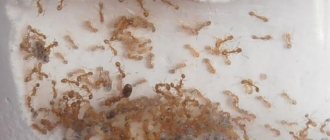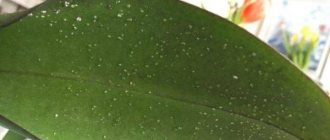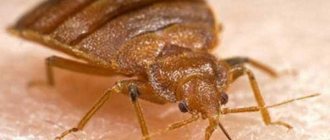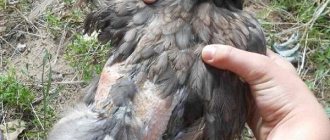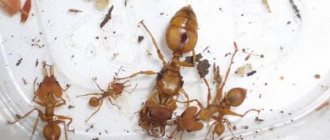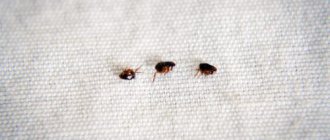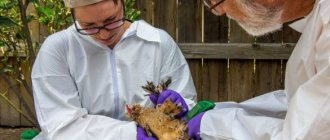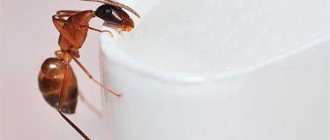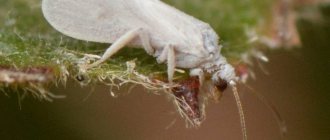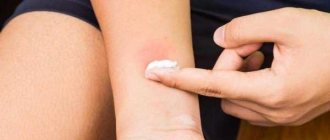Allergic rash similar to mosquito bites - what is it and how to fight it
From the article you will learn which allergies manifest themselves as rashes in the form of mosquito bites and other insects, as well as how to distinguish a mosquito bite from an allergy.
Mosquito bites, although not a pleasant event, are quite common in our lives. And during the period of activity of these insects, we do not pay much attention to the individual itchy blisters that appear on the skin every now and then.
But what if mosquito bites appear on the body, and it’s winter, when there are no mosquitoes nearby; fleas, ticks and other parasites capable of leaving such marks were also not found, and the rash in the form of mosquito bites still does not go away, persisting for several weeks, or even months.
In this case, first of all, suspicion falls on an allergy, namely on one of the varieties of its manifestation – urticaria.
The main reasons for the development of urticaria, or allergies in the form of mosquito bites, are allergies to insects, food products, medications, and infectious agents.
However, urticaria is a symptom not only of allergies, but also of autoimmune processes (an allergic reaction to the body’s own cells), toxicoderma (occurring when active and toxic chemical compounds get on the skin and into the body, from insect bites), disorders of the liver, as well as may occur when the skin is subjected to excessive physical exposure to cold, heat, sunlight, vibration, or pressure.
There are also other diseases whose symptoms are a similar rash:
- infectious diseases;
- diseases of the circulatory system;
- rubella, measles, herpes and some others.
Parasites
Often parasitic diseases lead to pimples popping up all over the body and itching like mosquito bites. Indeed, sometimes a person is attacked by parasitic insects, such as bedbugs, ticks, fleas and others, which leave red areas on the skin. These itchy bite marks can become infected and complicated by purulent inflammation.
The symptoms of the pathological condition, when after a parasitic infection a rash similar to mosquito bites appears and itches, depends on the type of insect. In such cases, the appearance of itchy blisters may be accompanied by:
- a burning sensation and itching at the site of the lesion,
- swelling of soft tissues,
- increase in local body temperature,
- peeling after flea and bedbug bites.
Read also: Why do lips itch, dry, crack, peel: treatment
What do mosquito bites look like?
Most often, mosquito bites manifest themselves as itching and the formation of reddish blisters on the skin. Below in the photo gallery you can see what the body’s usual inflammatory reaction to a foreign insect protein looks like.
What does a mosquito bite look like in adults and children: photo
Main symptoms of mosquito bites
Sometimes it is possible to distinguish manifestations of an allergy from a bite without visiting a doctor.
| Symptom | Photo |
| Mosquitoes most often bite exposed areas of skin, so you are unlikely to find marks under clothing (especially thick ones) | |
| Visually, the bite is quite pronounced, with reddish inflammation around it. Often this area is quite itchy. | |
| You may notice multiple bites after sleeping (especially in the summer). The presence of marks on several family members also speaks in favor of bites. |
Causes of allergic nature
Allergic reactions involving the skin are a common cause of blisters on the skin that resemble mosquito bites. In such cases, the disease develops after direct contact of the skin with a potential allergen or the entry of a probable allergy factor into the body. Often provoking factors are: household chemicals, food and medicines, which should be taken into account by people prone to developing allergic reactions.
Hives
The pathological condition is one of the dermatological diseases of allergic etiology. It is accompanied by the appearance of an itchy rash on the skin, which, as it develops, swells greatly, transforming into blisters. When the surface of such formations is damaged, they begin to bleed with the further formation of bloody crusts.
Allergy symptoms
Urticaria, or urticaria, is characteristic of an immediate allergic reaction, and therefore occurs within a few minutes after contact with the allergen.
Photo: characteristic appearance of allergic urticaria
The symptomatic manifestations of urticaria are similar to those caused by a nettle sting or an insect bite. It is due to the identity of the type of rash that allergies are similar to mosquito bites. Below are the main symptoms indicating an allergy.
- With this condition, blisters appear on the skin throughout the body - small, dense, swollen, raised elements of a round or irregular shape that can merge with each other. Please note that the rash in this case also occurs in areas covered by clothing
- The blisters are pale pink in color, and the surrounding skin is normal or reddened. The rash is accompanied by severe itching.
- Unlike a bite mark, which can remain unchanged for a long time, the rash disappears without a trace after the cessation of exposure to the allergen.
- The allergic reaction disappears quite quickly or becomes symptomatic when taking antihistamines
- People around you do not have any symptoms of the rash.
Actually, allergic reactions also occur to mosquito bites and other insects (especially in children) and there are few of them that can be confused with.
Familiarize yourself with the characteristics and treatment of this allergy, as well as photographs of allergic reactions to mosquitoes and other midges.
First aid
If blisters appear on the skin, similar to mosquito bites, which itch very much, but quickly disappear without a trace, you can reduce the severity of unpleasant symptoms with the help of:
- Applying a gel with antihistamine components (Fenistil gel).
- Taking tablets of any antiallergic medication (Zyrtec, Loratadine, Erius, etc.). Children are given such drugs in the form of syrup or drops.
- Compress made from soda solution. To prepare it, you need to dilute a couple of tablespoons of baking soda in a glass of water. Soak a cotton swab in this solution and apply it to the problem area for about five minutes.
- Green tea compress.
If the blisters become more and more numerous literally before your eyes, it is better not to risk it and immediately seek medical help.
Treatment of allergic urticaria
The action of the allergen that caused the reaction ceases. In addition, the patient should switch to an elimination diet that excludes foods with a large number of allergens (chicken, citrus fruits, nuts, eggs, strawberries, spices, foods with a high content of dyes).
In acute cases of urticaria, antihistamines are prescribed.
In the case of the development of a severe form of the disease, infusion antihistamines, corticosteroids (prednisolone, dexamethasone), calcium preparations that reduce sensitivity to allergens (calcium chloride or gluconate) are used; when the allergen is taken orally, gastric lavage is performed, and activated carbon and other sorbents are also used.
Preventive measures
People who experience attacks of allergic urticaria are also prone to developing urticaria in response to other external factors: light, heat, cold, pressure, mechanical damage to the skin.
To ensure that allergies similar to mosquito bites bother you as little as possible, you should adhere to the following recommendations:
- Avoid stress; on the recommendation of a doctor, it is possible to take mild herbal-based sedatives.
- Avoid allergenic factors to which the patient is hypersensitive.
- Stop smoking and drinking alcohol.
- Be exposed to direct sunlight as little as possible (sunbathing is contraindicated). Also avoid prolonged exposure to high and low temperatures, use creams that protect from ultraviolet radiation and heat, and from cold.
- Take a shower, wash your face and wash your hands only with warm water, using soaps with skin-softening and moisturizing additives, and dry with soft towels.
- Do not take aspirin, codeine, ACE inhibitors.
- Do not use wardrobe items that put excessive pressure on the skin (tight clothing, belts, suspenders). Give preference to cotton clothes.
- Hypoallergenic diet, healthy eating.
- Treat diseases of the gastrointestinal tract and liver, infections in a timely manner.
- Maintaining a daily routine, alternating work and rest.
All this will prevent the occurrence of an attack of hives, which will make life much easier for allergy sufferers.
Treatment options
Treatment of skin rashes should be prescribed by a doctor, since it is necessary not only to relieve the symptoms, but also to eliminate the cause of their appearance. To eliminate the rash and heal the skin, topical agents such as creams, ointments, and gels are most often prescribed.
Treatment
The most popular means:
- for allergies - Advantan, Nezulin, Afloderm;
- for insect bites - Fenistil gel, Psilo-balm, Rescuer;
- for atopic dermatitis - Afloderm, Elidel, Akriderm;
- in case the rash is caused by an infectious disease - Solcoseryl, Panthenol, Bepanten.
In case of a severe allergic reaction, antihistamines can be taken, and in case of severe infectious diseases, antibiotics can be prescribed.
In addition to pharmaceutical drugs, folk remedies are used to treat rashes. Many of them quickly get rid of blemishes on the skin without leaving marks. Most often used:
- herbal decoctions (chamomile, calendula, celandine, string) can be used for lotions or added to the bath;
- aloe (juice or pulp) – will speed up healing;
- baking soda solution – works great for itchy spots;
- alcohol or vodka – reduce inflammation and itching;
- fresh potatoes – relieves swelling, soothes itching.
Before using traditional recipes, it is also advisable to consult a doctor.
When does allergy in the form of mosquito bites occur?
Skin is one of the most sensitive anatomical structures of the human body. The appearance of an itchy rash on its surface, reminiscent of the consequences of contact with insects, suggests the presence of blisters. This is an element that does not have a cavity; it is swelling of the papillary layer of the connective tissue part of the skin. It is characterized by such symptoms as:
- existence for a short period of time (on average up to a day);
- combination with itching, burning;
- pink, in some cases – porcelain shade;
- round or irregular shape;
- tendency to merge.
The blisters disappear without transforming into secondary elements of the rash (cracks, erosions, ulcers, scars). Only in the case of intense scratching, scratches and wounds remain in the area of the affected areas - the consequences of active mechanical action, which heal within a few days and can serve as an “entry gate” for infection.
An allergy in the form of a mosquito bite is usually urticaria.
Before making a final diagnosis, other etiological (causal) factors not related to individual sensitivity, such as infection, must be considered. Some types of bacterial, viral, and fungal agents can cause redness, swelling, and rashes. In addition, insect bites (bugs, ticks) that were not noticed by the patient are quite likely.
Is it possible to scratch blisters on the body?
If unpleasant blisters are very itchy, it is natural that it is almost impossible to fight the urge to scratch them. It is especially difficult for children to resist this temptation. But doctors strongly recommend avoiding scratching, as this can lead to:
- Infection. When mechanically scratching, the inflamed area is easily injured, which is accompanied by a violation of the integrity of the epidermis. As a result, a wound forms on the skin - an ideal entry point for any infection.
- Spread of pathogens. In many infectious and parasitic diseases, blisters contain quite a lot of pathogens that, when scratched, can be transferred to still healthy areas of the body. This is fraught with the spread of the disease over a large area, as well as the entry of viruses or parasites onto clothing or bedding, as well as into the air.
- Scarring of the skin. If you tear off the blisters with your fingernails, scars may later remain in their place.
Therefore, adults need to do their best to distract themselves from the thought of scratching itchy places. And if the disease occurs in a child, you need to take all possible measures to prevent scratching (for example, use anti-scratch pads) and try to reduce the intensity of itching (using antihistamines, etc.).
Causes
Urticaria is a group of pathologies of an allergic nature, the basis of the pathogenesis (mechanism of development) of which is an immediate hypersensitivity reaction. The leading symptom is the presence of rapidly emerging and severely itchy blisters that disappear without a trace within up to 24 hours without secondary skin changes. There are several main reasons for the development of urticaria:
- Food products (citrus fruits, fish, nuts, peanuts).
- Medicines (antibiotics, vitamins, non-steroidal anti-inflammatory drugs).
- Insect bites (wasps, bees, hornets).
- Infectious agents (viruses, bacteria, fungi, helminths).
- Autoimmune pathologies (systemic lupus erythematosus, rheumatoid arthritis).
- Physical triggers (low and high temperature, vibration, sunlight, pressure, humidity).
Factors that contribute to the development of urticaria include:
- hereditary predisposition;
- diseases of the digestive tract, endocrine and nervous systems;
- infections and neoplasms.
Stress plays a part. It has been proven that nervous tension (including due to a change of place of residence, climatic conditions) affects the immune system and can lead to malfunctions in its functioning, which sometimes results in allergic sensitivity.
Symptoms in adults
Urticaria is classified as:
- acute (episodes of rash observed over a period of time lasting less than 6 weeks);
- chronic (repeated for more than 2 months);
- localized (rash occurs in separate areas of the skin);
- systemic (blisters cover the entire body).
Urticaria is a disease in which not only the skin is involved in the pathological process. There are likely additional signs that determine the severity of the sensitivity reaction.
Dermatological manifestations
The dominant group of symptoms, characterized by damage to the skin. Observed:
Blisters due to urticaria can be localized on absolutely any part of the body. Location on the scalp, palms and soles is not excluded. They itch very much.
If the rash occurs on the face, it practically does not rise above the skin level. The elements start out pink and soon become porcelain. This occurs due to compression of blood vessels as a result of increasing edema. Then, as the swelling decreases, the blisters turn red again and then disappear from the surface of the skin.
Quincke's edema
This form of reaction can be classified as a dermatological manifestation, but it is worth considering it separately. According to statistics, more than half of the episodes of urticaria are accompanied by angioedema; it is a dense swelling affecting the subcutaneous tissue. There is no intense itching. Changes can be localized in areas such as:
- face (lips, cheeks, eyelids, ears);
- external genitalia;
- oral cavity, nasopharynx;
- mucous membranes of the digestive and urinary organs.
The most dangerous is Quincke's edema in the larynx - it causes a narrowing of the airway and can lead to asphyxia (suffocation).
Additional manifestations
Allergies that look like mosquito bites can be characterized by the following symptoms:
- General weakness.
- Increased body temperature.
- Runny nose.
- Watery eyes, swelling of the eyelids.
- Pain in muscles and joints without specific localization.
Sometimes patients are bothered by a cough; symptoms of damage to the digestive tract are likely - lack of appetite, nausea and vomiting, as well as diarrhea in combination with flatulence and abdominal pain. These signs can be associated either directly with urticaria or with Quincke's edema.
An allergy sufferer may complain of fatigue, poor sleep, becomes irritable due to itching, and is unable to concentrate on everyday tasks.
Symptoms in children
Patients belonging to the younger age group often experience urticaria associated with food or drugs, as well as other triggers. Allergies in a child are characterized by the following symptoms:
- swelling and itching of the skin;
- the appearance of a rash in the form of blisters;
- increase in body temperature.
Fever can be observed even in infants and often causes misdiagnosis of infection, as it can reach high numbers. Children can suffer a systemic or generalized form of urticaria, which is combined with angioedema and is considered a life-threatening condition. But even with a mild reaction, the need to itch can lead to skin defects (wounds, ulcers) and infection.
Causes of the rash
A rash that looks like mosquito bites can occur for the following reasons:
- Prickly heat.
- Hives.
- Allergic reaction.
- Infection.
- Insect bites.
A thorough examination of the problem area will help you understand what exactly led to the rash. You need to pay attention to where exactly the pimples are located - on the face, arm, stomach or leg. The presence of accompanying symptoms, for example, irritation and itching, is also taken into account.
In the summer, people rarely have questions about why pimples form on their skin. Everyone is accustomed to blaming various insects for this, which tend to attack a person and feed on his blood.
A feeling of anxiety appears when pimples similar to mosquito bites are found in winter. In this case, the rash can be attributed to a disease developing inside the body.
Hives
Children and adults may show signs of urticaria in the form of pimples that resemble marks after bites of blood-sucking insects.
Hives are recognized by pale pink blisters that rise slightly above the surface of the skin.
They resemble peculiar burns that occur after contact with nettles. This rash will be very itchy.
An increase in the severity of urticaria symptoms occurs after a person interacts with any irritant. This may include pet hair, pollen, medications, perfumes and cosmetics, solar radiation, and even low temperatures. It is very important to identify what exactly causes discomfort and immediately stop contacting it.
Food allergies
Strange spots that closely resemble ordinary mosquito bites appear on different parts of the body after a person eats a product that provokes an allergic reaction.
READ ALSO: Insidious infectious mononucleosis: let's figure out why it is dangerous and how to detect it
This usually happens after eating seafood, citrus fruits, milk and honey. Chocolate products and natural honey are often the culprits of illness.
This disorder is recognized by its characteristic symptoms:
- The appearance on the skin of small tubercles and spots that differ from each other in size. Their location is chaotic.
- The formation of such elements some time after consuming a certain product or medicine.
- Rapid disappearance of the rash after taking a drug with an antihistamine effect.
- Instant increase in the size of pimples and their rapid growth.
In case of allergies, it is necessary to immediately cleanse the body of toxic substances that cause deterioration in health. Sorbents help cope with this task. Also, do not forget about antihistamines.
More recently, measles was a relatively rare disease. But recently, outbreaks of the disease have become noticeably more frequent.
This is because a minimal percentage of people today agree to be vaccinated against measles. The disease makes itself felt with a sudden increase in temperature, redness of the throat and dry cough.
Around the 5th day of infection, small papules appear. They are located on the face and gradually spread to different parts of the body.
If left untreated, the likelihood of infection in the digestive, nervous and respiratory systems increases.
Rubella
Another viral infection that is usually diagnosed in young children. It causes a rash that is somewhat reminiscent of insect bites.
Gradually, the pimples turn into noticeable spots. Along with this, other symptoms of the disease arise:
- Enlarged lymph nodes in the back of the head and neck.
- Increased body temperature.
- Headache.
This disease poses the greatest threat to pregnant women. The pathological process can interfere with the development of the fetus, which is fraught with various disturbances in the functioning of the organs of vision, blood vessels and heart.
Diagnostics
There are several main clinical criteria in favor of urticaria:
- Sudden onset of itching and blisters.
- The presence of a connection with the allergen (most often, contact with it occurs 30–60 minutes before signs of a reaction appear).
- The fleeting nature of the rash (that is, rapid disappearance without secondary elements).
In addition, anamnesis is important - information about past episodes of pathology, the presence of allergies (not necessarily urticaria) in close relatives. Additional methods are used to clarify the diagnosis.
Laboratory tests
May include different types of tests - from basic general clinical ones (determining the level of hemoglobin, red blood cells, counting leukocytes, examining urine and feces) to complex special ones:
- enzyme-linked immunosorbent assay (ELISA) to detect antibodies to reaction provocateurs - food products, insect venom, etc.;
- determination of markers of infections (in particular, viral hepatitis);
- serum tryptase level test;
- assessment of thyroid function indicators (hormonal panel).
It is also important to identify signs of helminthiasis, for which stool is examined for worm eggs and the use of ELISA to detect antibodies to parasites (giardia, opisthorchid, toxocara).
Skin tests
These are provocative tests to check for sensitivity. They involve applying a potential trigger to the forearm or back and waiting within a specific time period (minutes, hours).
For example, if the patient reacts to cold, a piece of ice in a moisture-proof wrapper is applied to the skin (to prevent contact with water, which can also cause urticaria). In case of intolerance to drugs or food, use special media that contain the suspected allergen. If signs of a reaction (redness, swelling, itching, blister) occur during the observation period, sensitivity is considered proven.
Treatment for children and adults
Treatment for skin rashes that itch, like mosquito bites, depends primarily on the cause of their appearance:
- If you have an allergy, you need to relieve unpleasant symptoms with antihistamines. Afterwards, you need to find out which substance caused the reactions of individual intolerance and refuse contact with it in the future.
- Chickenpox usually does not require targeted therapy; treatment is symptomatic. The elements of the rash are lubricated with an antiseptic (for example, Fukortsin), and the temperature is lowered if necessary. The patient is indicated for quarantine, as the disease is highly contagious. If chickenpox develops in adulthood, additional antiviral drugs (acyclovir, valacyclovir, etc.) may be required, as well as immunostimulating drugs to prevent complications.
- Herpes on the skin is lubricated with antiviral drugs (aciclovir-based ointments are the drugs of choice), and such drugs can also be taken orally according to a regimen selected by the doctor. At the same time, the patient needs to increase the body’s defenses to prevent relapses.
- Herpes zoster requires complex therapy. It is practiced to take antiviral drugs (based on acyclovir, famciclovir and valacyclovir), painkillers and anti-inflammatory drugs, for example, diclofenac, indomethacin, etc. In case of severe pain, novocaine blockades are carried out. Rashes are treated with antiseptics - brilliant green or Fukortsin. Doctors usually insist on immunomodulatory therapy for a speedy recovery and prevention of complications and relapses.
- Scabies requires complex treatment, which consists of local application of anti-scabies and careful treatment of the patient's clothing, bed linen, room, etc. Doctors also insist on preventive therapy for all persons who have been in contact with the sick person.
Treatment methods for rashes are selected individually by an experienced dermatologist, pediatrician or therapist. Attempts at self-medication can cause serious harm to health and cause unwanted complications.
Treatment
Treatment for urticaria is carried out both at home and in a hospital department - it depends on the patient’s condition, the severity of symptoms and the presence of life-threatening signs. We must not forget that blisters on the skin can be a harbinger of anaphylactic shock - a reaction manifested by a sharp drop in blood pressure (collapse) and, like angioedema in the larynx, requiring emergency care.
Stopping contact with the trigger
It forms the basis of the treatment of any variant of urticaria and implies the absence of contact with the substance or physical factor that causes the reaction. Experts call this method elimination; it includes:
- Regular wet cleaning (elimination of dust and mites).
- Refusal to keep pets (relevant if you are sensitive to hair and secretions - saliva, urine).
- Excluding allergenic foods from the menu (in case of food intolerance).
- Selection of cosmetics that do not contain trigger components.
- Avoid using medications that cause reactions.
Elimination measures are observed throughout life. In children, sensitivity may disappear as they grow older, so control may be weakened - but only if you are sure that the immune system does not respond to contact with the provocateur.
Hypoallergenic diet
Must be strictly observed during the period of acute manifestations of the reaction (that is, when a rash or itching occurs); after the condition improves, the list of permitted products expands.
- bran bread;
- dull fruits and vegetables in heat-treated form;
- dryers, crackers;
- lean meat, fish;
- dairy products;
- cereals
Drinks allowed are still water, dyes, weak tea, and compote. You shouldn't eat:
- citrus;
- strawberries;
- chocolate;
- whole milk;
- mushrooms;
- red meat;
- canned food;
- tomatoes;
- radish;
- processed cheese;
- spicy seasonings.
You need to eat dishes prepared by boiling, stewing or baking in the oven. A great way is steam treatment. Excess sweets, semolina and legumes should be avoided. Oatmeal, offal (liver, kidneys) are limited.
Drug therapy
Various medications may be used to treat hives:
| Pharmacological group | Representatives | Destination purpose |
| Histamine H1 receptor blockers | Loratadine, Erius, Zyrtec, Fenistil | Rapid reduction of itching, swelling, elimination of rash. Therapy of Quincke's edema. |
| Glucocorticosteroids | Elokom, Prednisolone, Dexamethasone | |
| Adrenergic agonists | Adrenaline, Epinephrine | To provide emergency care for severe urticaria, laryngeal edema, anaphylactic shock |
| Mast cell membrane stabilizers | Ketotifen, Sodium cromoglycate | For long-term therapy with frequent relapses (repeated episodes) of urticaria. |
For children from 6 months old, you can use Zyrtec, Desloratadine, and if the child is younger, with the permission of the doctor, a short course of treatment with Dimetindene is allowed.
Prevention and useful tips
To avoid recurrence of urticaria, you must:
- Avoid contact with triggers.
- Stick to a hypoallergenic diet.
- Take a course of treatment.
People who are aware of a tendency to sensitivity reactions should carry antihistamine tablets (for example, Cetrin). You should choose drugs without a sedative (calming) effect - otherwise drowsiness and decreased ability to concentrate are possible.
If a child suffers from urticaria, you need to warn the adults around him about the diagnosis. These are older relatives (grandparents, etc.), a kindergarten teacher, a school teacher, and a teacher in a club or sports section. It is better if your son or daughter always has with him the medications recommended by the doctor to relieve the symptoms of urticaria, as well as a card indicating the diagnosis and the contact number of the family.
- Spring Fever: Let's Say Yes! healthy lifestyle
- Fitness from the cradle: introducing your child to a healthy lifestyle
- Healthy eating pyramid
- Cold allergy: what you need to know
- What you need to know about allergies
Healthy lifestyle © 2022 Attention! The information published on the site is for informational purposes only and does not constitute a recommendation for use. Be sure to consult with your doctor!
